In general, gardeners and landscapers try to avoid green colors in their gardens as much as possible. This is due to the fact that neon green colors will obviously blend into many other green colors that will be in the plants’ immediate environment – even planted on their own they could just blend into the grass.
The last thing you want to do is spend a whole season growing a plant only for it to be unrecognizable amongst your other plants.
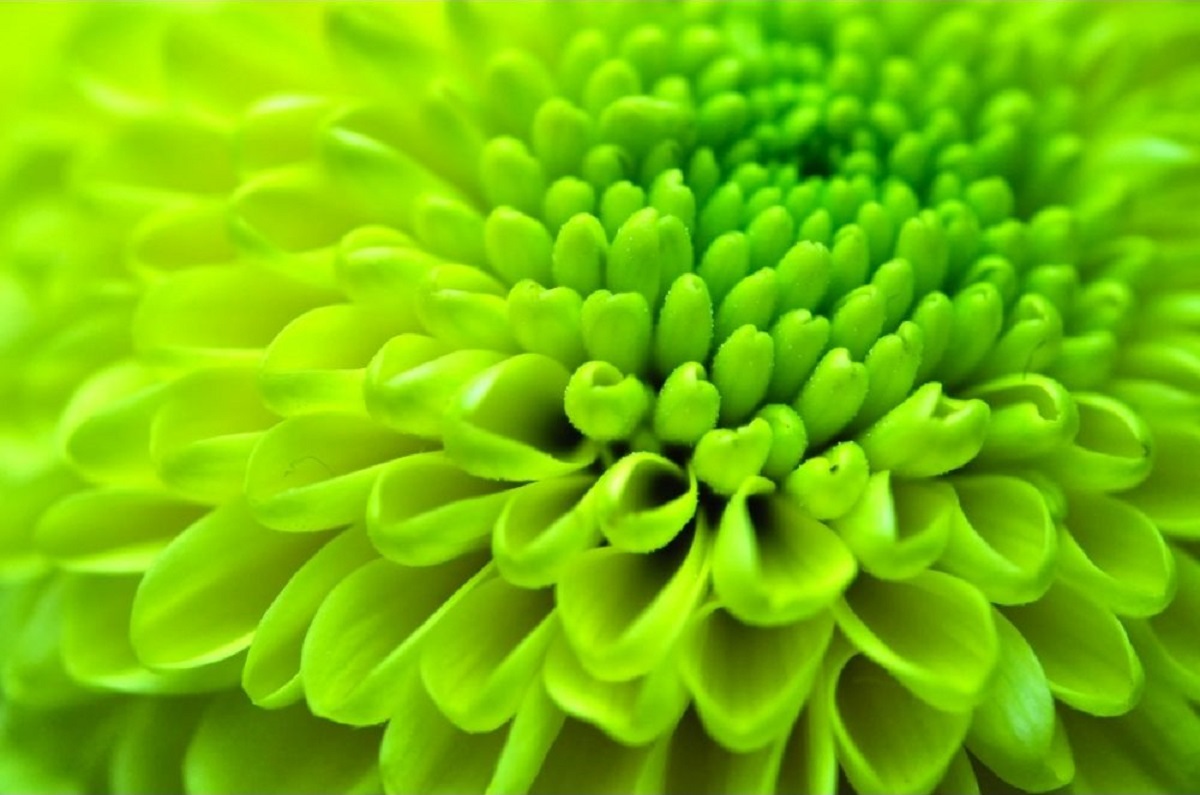
However, the neon green or lime green flower can be super fun to experiment with, as well as pairing well with almost any other color, and when used in the right context can show the nuance of your gardening eye.
Moreover, using green can symbolize nature itself, growth, refreshment, and peace. The abundance of green in your garden will never really look out of place.
1. Heuchera ‘Green Spice’
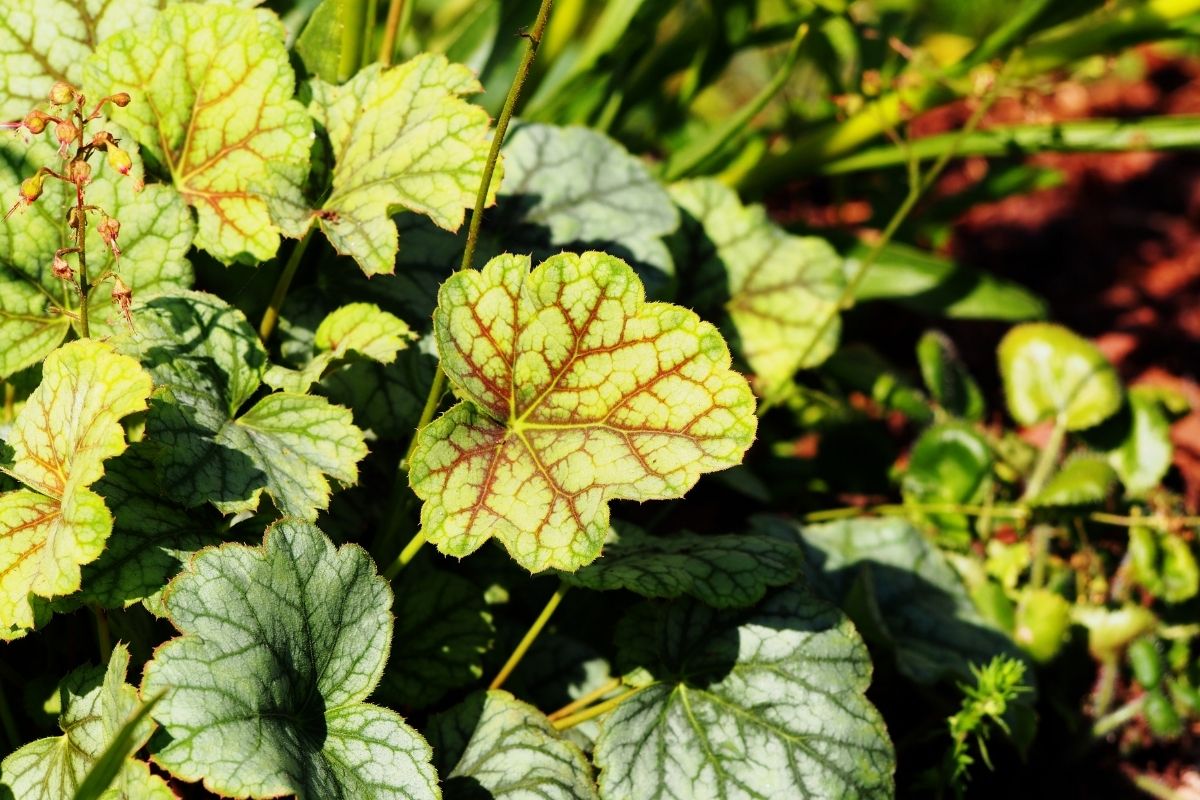
This cultivar is a species known as Heuchera from the Saxifragaceae family, all of which are native to North America but will grow in any temperate environment. Heuchera has wide fan-like leaves that are often very bold in their colors and certain varieties have visible veins in leaves.
Often, it is the leaves themselves that attract people rather than their inflorescence. However, the Heuchera does bloom in open panicles which are often white. Gardeners love Heuchera for their hardiness as well as their bold colors, they grow easily in a temperate environment.
This particular cultivar has bright green leaves, hence its name ‘Green Spice’. This is a great way to get some green into your beds while still being an attractive and interesting cultivar.
Commonly, your beds will be the base color of brown or black from the soil, so this is a great choice for something to bring some freshness to those beds with an interesting plant that doesn’t necessarily steal all the spotlight. Unconvinced?
This specific cultivar has been awarded the Royal Horticultural Society Award for Garden Merit (RHS AGM).
2. Hosta ‘Lemon Lime’
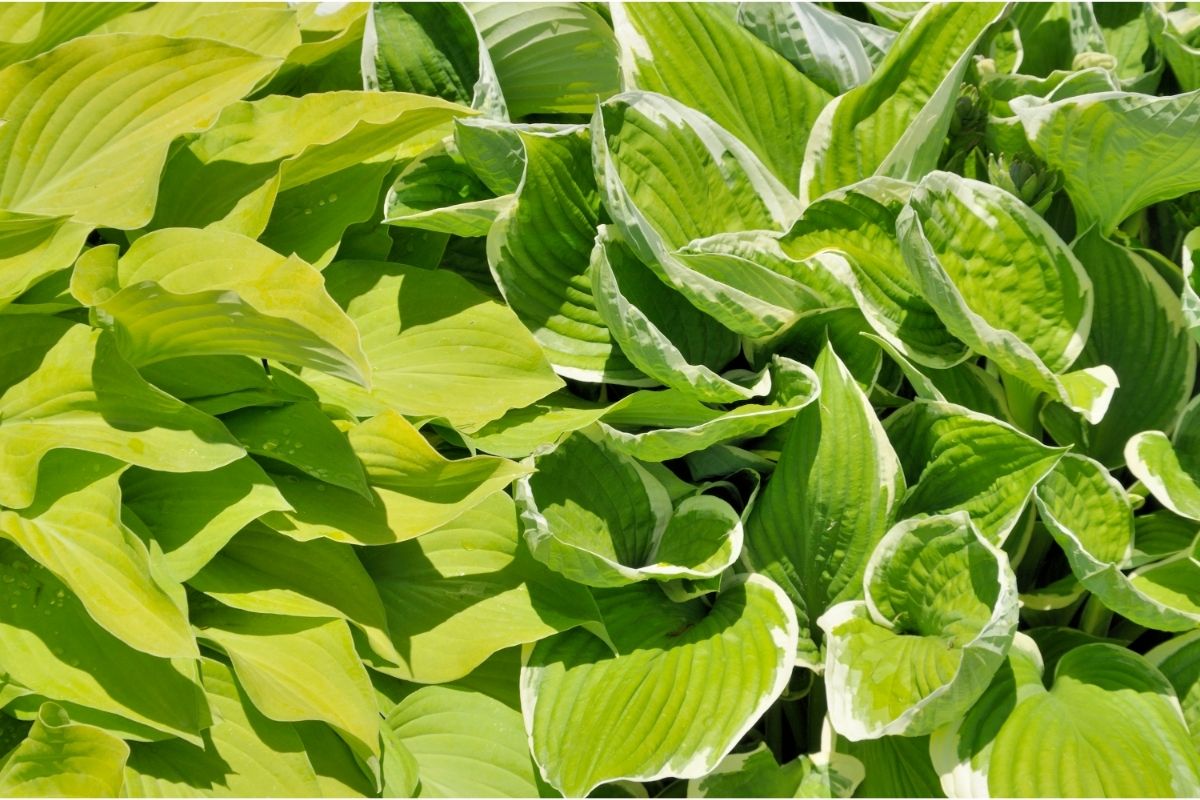
Hostas are a shady-loving plant from the Asparagaceae family, they are used frequently within shady gardens as they are easy to grow and can have some cool foliage when in bloom. Hostas do bloom flowers but are mainly cultivated for their ornamental foliage which can vary widely.
They can generally get to 10 inches in height and potentially 15 inches in spread. They require regular watering but can be planted in borders or their own pot.
This particular cultivar has some dramatic green foliage that is a great way to bring more fresh colors into your garden. The ‘Lemon Lime’ cultivar lives up to its name with some bold shades of green and yellow that make it stand out.
Particularly in shady gardens, a Hosta will grow very well while others need more sun. On the other hand, you can grow this Hosta in a planter along with other flowers for some interesting color blends.
3. Ilex x Meserveae ‘Castle Gold’

The Ilex is an interesting shrub that has some cool foliage, you may know it by its common name ‘Holly’. As a result, this is a great plant to look for in the winter months, not only because it is festive but because of its green foliage.
There are 560 species of this plant and certain cultivars have bold foliage worth looking into for padding out a winter garden.
Specifically, this cultivar named ‘Castle Gold’, is a female Ilex that has some boldly green foliage. This would look great in its independent pot, although it will have to be potted up as the plant grows, to bring some color to the front of a building or a patio.
Conversely, Ilex is commonly used in winter gardens as they do well in these temperatures. The green would bring some great contrast to a snowy garden or even just the dark colors of soil.
Moreover, if you are creating a festive garden display, the green foliage is not only linked with Christmas anyway but would bring some welcome freshness. Or, this would be great to harvest the branches and use for a striking Christmas decoration or wreath.
4. Euphorbia Characias Subsp. Wulfenii
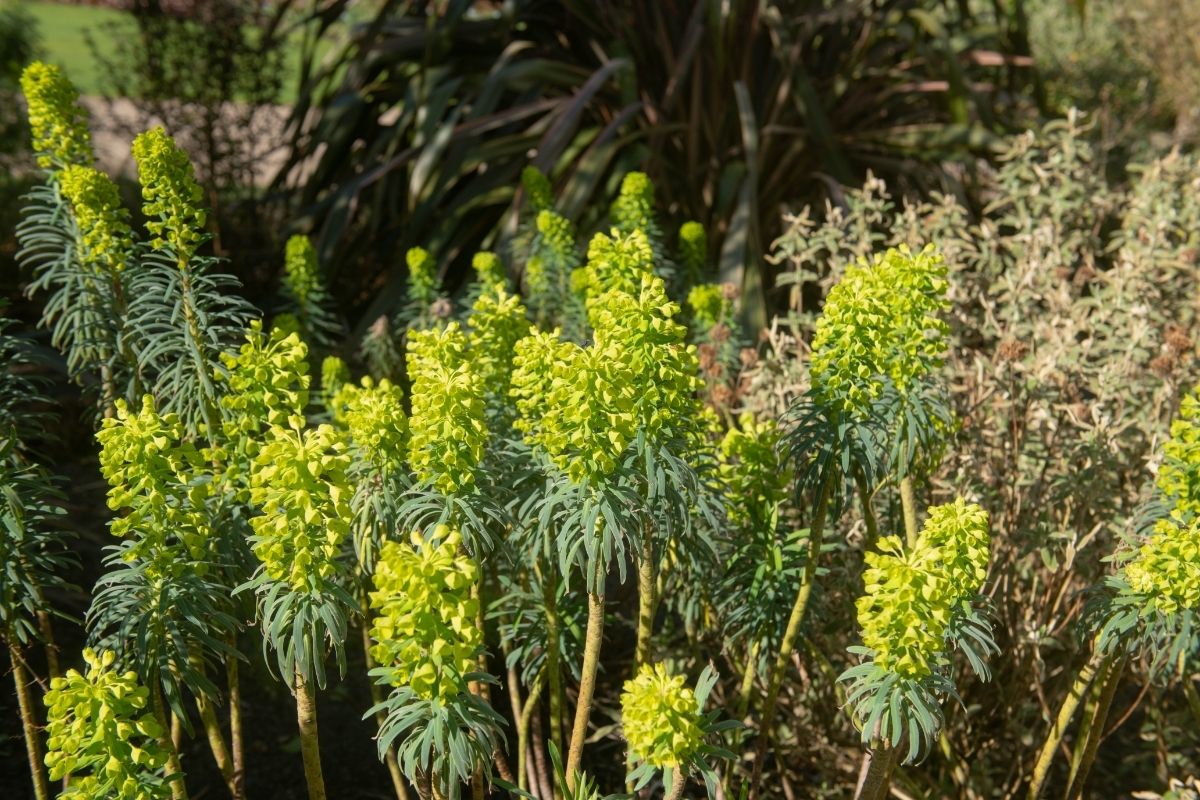
The Euphorbia is a medium-sized shrub that has a unique inflorescence that can create some bold colors. The genus is generally quite diverse, but specifically, the characias variety has some wooly stems as well as characteristically dark nectar glands.
This species is particularly found within Mediterranean environments but is also present in many Western environments. However, be careful with specific Euphorbias as they release a ‘milk’ that is relatively toxic and could irritate the skin of humans and other animals.
The specific subspecies of the Euphorbia characias known as wulfenii is particularly of interest for those who are seeking a neon green plant. Obviously, the plant isn’t neon green, but the combination of its green foliage with yellow inflorescence panicles is as close as you will get to a neon vibe.
These Euphorbias will grow well in dry environments so are great for a hotter and more arid climate of a garden – they should stand out quite brightly.
5. Primula ‘x Polyanthus ‘Green Lace’
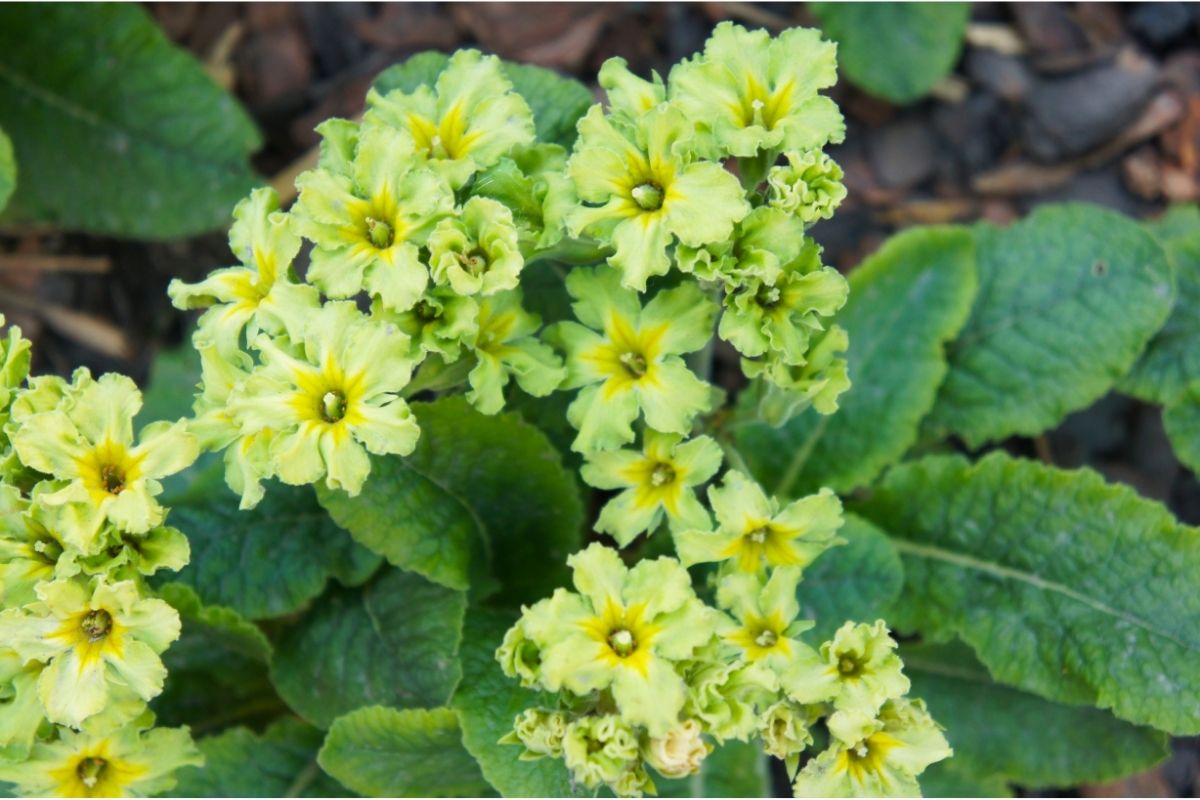
Polyanthus are a large and varied group of primulas, they are known for their unique and bold flowers that come in many dramatic colors.
Primulas in general can survive hard winters and will bloom in the spring. You may be forgiven for thinking this could be a modern hybrid, but it’s actually been around since the mid-1600s and has become popular for the showy flowers since this period.
This particular cultivar ‘Green Lace’ has some extremely curious flowers. The petals of the inflorescence are almost exactly the same color as the foliage, which is quite unique. The center of the flower gets lighter and becomes yellow the closer to the center.
The combination of the yellow and green makes them look neon at some point. This is another great way to add some freshness to a dull-colored bed. When the flower is harvested on its own it looks especially spectacular.
6. Zinnia Elegans ‘Envy’

Zinnia is a genus of the family Asteraceae, it’s a perennial flowering plant also of the sunflower tribe Heliantheae which looks very similar to the Zinnia.
They are endemic to the dry regions of the southern United States as well as in South America and Mexico, the latter is where you can find the most diversity. A Zinnia of any kind will do well in a garden display of a dry climate. The plant’s strange name comes from the master botanist Johann Gottfried Zinn.
Zinnias in general can differ from sunflowers as they have double petals that surround the central disc flower. The cultivar ‘Envy’ is of particular interest to us for its shockingly green inflorescence. Just think of your common sunflower, but instead of bold yellow petals, replace them with boldly green petals instead.
Among actual sunflowers, these Zinnias can look really cool. Moreover, they are tall, like Sunflowers, and can do well alongside other tall plants or if you want something bright that adds height to your display, then these Zinnias are a good choice.
RELATED: A Tropical Paradise: 10 Different Types Of Tropical Rainforest Trees
7. Nicotiana Alata ‘Lime Green’

Nicotiana is what is commonly known as the tobacco plant, however certain species of the tobacco plant can produce flowers. Nicotiana is a perennial plant in the Solanaceae family. They are mainly native to the south Americas, especially Brazil and Argentina. When mature they grow into evergreen shrubs.
They are generally really versatile plants that are unfussy, they can grow in most soils and enjoy both shade and sun. They have a long blooming season which is great for borders. Be careful, however, as the plant will self sow when near the end of its life cycle and will cause a serious infestation of a border if allowed to self-sow.
However, this particular species and cultivar is a flowering tobacco plant. The inflorescence of this cultivar, ‘Lime Green’, is the main attraction as it has trumpets of lime green petals that in the sun can look quite neon.
We would recommend using them among other purple flowers as this cultivar blends really well with this kind of color but is versatile among others. The pest-free and low maintenance shrub will get around 1-3ft in height so is a great way to add height to a border with little effort but still creating a striking display.
Conclusion
So, as you can see there are some surprising characters on this list, who you may not think could produce a flower of this color. Unsurprisingly, green is probably the color you will encounter the most in the plant kingdom thanks to the life force of chlorophyll.
However, it can be really interesting and spectacular when green flowers are produced from green plants.
Many people shy away from these flowers due to their ability to blend in but with the right mindset a gardener can really show off their flair with plants by utilizing the color green well and in complement to other plants, creating a spectacle that is greater than the sum of its parts.
Editor’s Recommendations
10 Perfect Pear Flowers (With Pictures)







